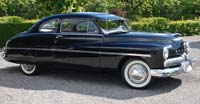












1949 Mercury |
|||
| Classic and Hot Rod Cars And Their Stories | |||
| 1949 Mercury | |||
The 1949-51 Mercurys are perhaps the most popular Mercurys of all time. The 1949 Mercury was originally slated to be the first post-war Ford but the car ultimately became the new post-war Mercury. Four body styles, three shared body shells with the jinior Lincoln line though on three inch shorter wheel base. The 1949 Mercury, like the 1949 Ford, was also a great marketing success, and the tremendous public acceptance helped Ford Motor Company surpass Chrysler as the number 2 automaker behind General Motors by 1951. The 1949 Mercury had a brand new chassis with independent front suspension, Hotchkiss drive, and a live axle on parallel longtitudinal leaf springs, replacing Ford Motor Company's long-time single transverse leaf. Its flush-fender "inverted bathtub" styling was massive, yet clean and streamlined. The chrome verticle bar grille ran practically the entire width of the car with outboard aligned parking lights, and the grille was divided at the center with a thick chrome verticle bar. "M-E-R-C-U-R-Y" was spelled out above the grille on the base of the hood. Centered above the letters was the Mercury emblum. A single bright molding ran the full length of the car at mid-body. Horizontal, oval-shaped taillamps provided illumination from the rear. Mercurys came in a single series offering four body styles: Coupe, Sport Sedan with suicide rear-hinged back doors, Convertible, and an attractive two door "woody" station wagon, featuring less structural wood than previous years' four door models. 1950 and 1951 model Mercurys were based on the same Lincoln body shell and continued the sales success of the '49 models with 294,000 sold in model year 1950, and another record-breaking 310,000 plus for the 1951 model year, again achieving sixth place in the Industry. Styling remained virtually the same, except 1951 saw more prominent grille bars and verticle taillamps. 1951 also saw the introduction of an optional extra cost new self shifting three speed fully automatic transmission developed by Borg-Warner called "Merc-O-Matic". |
|||
Note: All Images And Stories On This Site Are Copywrited. Use Of Any |
|||
 Great Pricing & Selection of Cameras and Accessories: Top Camera Mall |
|||
|
|||

